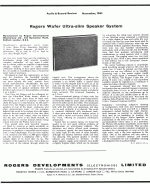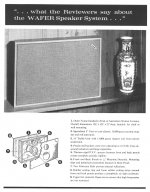When building a shallow cabinet, how much space could minimally left behind the drivers? My woofers have air holes on the back, so I'm pretty sure its a bad idea to block those off, but I want to know how shallow I can make my cabinet. Does it depend on the expected frequencies and dB the woofer will be producing (in this case, high 120dB and between 120-700hz)?
Thanks in advance!
Thanks in advance!
A rule of thumb I'd use might be ' Top of magnet assembly to inside baffle panel, times 0.5 ' This best guess will assume the somewhat close proximity of the rear wall panel will be well damped'
I've seen & pondered some really shallow baffles...my 2 cents.
-------------------------------------------------------------------Rick.....
I've seen & pondered some really shallow baffles...my 2 cents.
-------------------------------------------------------------------Rick.....
Wow, apparently you can still get Tygan fret grill cloth...
Speaker Grille Cloth Tygan black, 31,40 €
Speaker Grille Cloth Tygan black, 31,40 €
The objective would be not to significantly restrict the air flow through the hole. The area of the hole is pi*r^2, where r is the radius of the hole, and the initial area the air would escape through would be pi*2*r*d, where d is the depth behind the magnet. Matching these gives d = r/2. There will be some loss in turning but any radius on the hole lip (fairly likely) will help the discharge coefficient significantly. So d > r/2 is likely to be OK but any smaller and the air flow will definitely be restricted.When building a shallow cabinet, how much space could minimally left behind the drivers? My woofers have air holes on the back, so I'm pretty sure its a bad idea to block those off, but I want to know how shallow I can make my cabinet.
Wow, apparently you can still get Tygan fret grill cloth...
Speaker Grille Cloth Tygan black, 31,40 €
Never mind the grille cloth many of the drivers from the 70s are back in production. I knew about the KEF B110 and T27 from the LS3/5A hoo-hah but the KEF B139 and the Coles 4001G are also being manufactured again.
A rule of thumb I'd use might be ' Top of magnet assembly to inside baffle panel, times 0.5 ' This best guess will assume the somewhat close proximity of the rear wall panel will be well damped'
I've seen & pondered some really shallow baffles...my 2 cents.
-------------------------------------------------------------------Rick.....
The objective would be not to significantly restrict the air flow through the hole. The area of the hole is pi*r^2, where r is the radius of the hole, and the initial area the air would escape through would be pi*2*r*d, where d is the depth behind the magnet. Matching these gives d = r/2. There will be some loss in turning but any radius on the hole lip (fairly likely) will help the discharge coefficient significantly. So d > r/2 is likely to be OK but any smaller and the air flow will definitely be restricted.
Thanks for the input! I'll implement it like this, thanks. So if the airhole is 4cm (in my 12" Beyma driver), I could get away with leaving only 2cm behind this driver? To be safe I'd add another centimeter.
Thanks for the input! I'll implement it like this, thanks. So if the airhole is 4cm (in my 12" Beyma driver), I could get away with leaving only 2cm behind this driver? To be safe I'd add another centimeter.
Many years ago in my teens, I put a 12" subwoofer driver in a cabinet just slightly deeper than the depth from the basket to the bottom of the motor.
I used a circle jig and router to make a through hole directly behind the motor, large enough for the bottom plate of the motor, and a recessed ledge on the outside of the cabinet 3/16" deep.
A piece of 1/8" inch aluminum plate was made to fit in the recess with foam tape and screws. Space behind the pole vent was approximately 1/2".
I would consider it again if needed for a shallow cabinet.
I've done about 4mm on an 8" driver, where it was essential that I have the smallest box I could make for it (for horn loading).
Consider the valves in car engines. They don't open far, but the cylindrical surface around their rims actually gives them plenty of air flow.
Consider the valves in car engines. They don't open far, but the cylindrical surface around their rims actually gives them plenty of air flow.
I would check with Beyma to be sure.
Take for example the JBL 2206, also a 12". They recommend a minimum of 3" (76mm) clearance behind the magnet for proper operation of the "Super Vented Gap" cooling.
Obviously, your driver isn't exactly the same as the 2206, but checking directly with the manufacturer would be best IMO.
Take for example the JBL 2206, also a 12". They recommend a minimum of 3" (76mm) clearance behind the magnet for proper operation of the "Super Vented Gap" cooling.
Obviously, your driver isn't exactly the same as the 2206, but checking directly with the manufacturer would be best IMO.
- Status
- Not open for further replies.
- Home
- Loudspeakers
- Multi-Way
- Amount of space behind drivers

